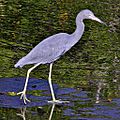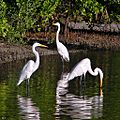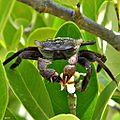Mangrove swamp facts for kids

A Mangrove swamp is a distinct saline woodland or shrubland habitat formed by mangrove trees. They are characterized by depositional coastal environments, where fine sediments (often with high organic content) collect in areas protected from high-energy wave action. The saline conditions tolerated by various mangrove species range from brackish water, through pure seawater (3 to 4%), to water concentrated by evaporation to over twice the salinity of ocean seawater (up to 9%).
Birds sanctuaries
Mangrove swamps are home and sanctuaries for thousands of aquatic bird species, including:
- Pulicat Lake Bird Sanctuary
- Mangalavanam Bird Sanctuary
- Salim Ali Bird Sanctuary
- Pichavaram
- Coringa Wildlife Sanctuary
- Sundarbans National Park
Natural coastal protection
Mangrove swamps protect coastal areas from erosion, storm surge (especially during hurricanes), and tsunamis. The mangroves' massive root systems are efficient at dissipating wave energy. Likewise, they slow down tidal water enough so its sediment is deposited as the tide comes in, leaving all except fine particles when the tide ebbs. In this way, mangroves build their own environments. Because of the uniqueness of mangrove ecosystems and the protection against erosion they provide, they are often the object of conservation programs, including national biodiversity action plans.
The protective value of mangrove swamps is sometimes overstated. Wave energy is typically low in areas where mangroves grow, so their effect on erosion can only be measured over long periods. Their capacity to limit high-energy wave erosion is limited to events such as storm surges and tsunamis. Erosion often occurs on the outer sides of bends in river channels that wind through mangroves, while new stands of mangroves are appearing on the inner sides where sediment is accruing.
Images for kids
-
Mangrove ecosystem in the coastal intertidal zone Seagrass and oyster beds can inhabit the shallow subtidal zone -
Diversity of mangroves is greatest in Southeast Asia Distribution of delta, estuary, lagoon and open coast mangrove types in (i) South Asia, (ii) Southeast Asia and (iii) East Asia Bar charts show percentage change in area between 1996 and 2016 -
Sundarbans, world's largest mangrove forest -
The scorpion mud lobster is found in some mangrove swamps. It lives in burrows up to 2 m (6.6 ft) deep, and is active at night. Its burrowing is important for the recycling of nutrients, bringing organic matter up from deep sediments.
-
Fate of mangrove primary production A.) Fate of mangrove primary production and importance of each component, as a percentage of net mangrove primary productivity. B.) Isotopic profile of sediments across the transition from mangrove to intertidal mudflats and seagrass beds, illustrating the retention of mangrove productivity within the forest. -
Mangrove roots act as a net, retaining waste. Mayotte at low tide
-
Mangrove kingfishers are found particularly in mangrove zones
-
Brown pelicans fish and nest in mangrove forests
-
Little blue heron. The water is reflecting green mangrove trees.
-
Three great egrets fishing along a mangrove shore
-
Mangrove snapper swimming among mangrove roots
-
Old World silversides schooling among mangrove roots
-
Barracuda lurks among mangrove root
-
Yellow seahorses breed and give birth in Asia’s flooded mangrove forests. Tangled roots and submerged branches offer shadowy shelter to pregnant dads and their offspring
-
Mudskippers can be found in mangrove swamps
See also
 In Spanish: Manglar para niños
In Spanish: Manglar para niños






























